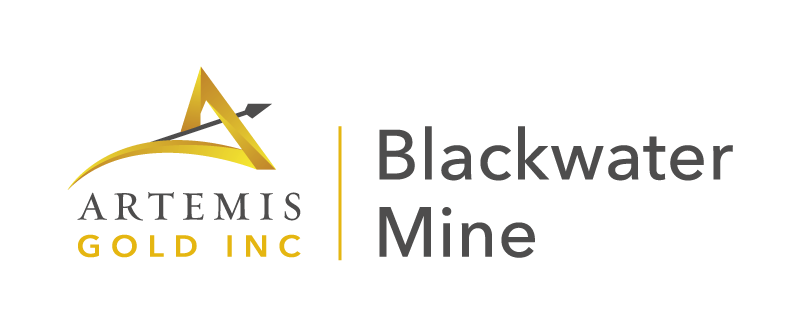Recent Updates
Blackwater Mine posted the following document:
- 2025 Condition 10.4.2 and 10.4.3 Reports
Blackwater Mine
The first pour of gold and silver doré at Blackwater Mine occurred on January 29, 2025 and commercial production was announced May 2, 2025.
The mine is located in central British Columbia, approximately 160 km southwest of Prince George and 446 km northeast of Vancouver. The mine is accessible by major highway and access/service roads. Artemis has a 100% recorded interest in 329 mineral claims covering an area of 148,902 ha distributed among the Property and the Capoose, Auro, Key, Parlane and RJK claim blocks. Surface rights over the Project area are controlled by the Crown.
The Blackwater Mine project is comprised of the construction, operation, and closure of an open pit gold and silver mine and ore processing facilities commencing with a nominal milling rate of 16,000 t/d (6.0 Mtpa). The ore processing facilities will be expanded to achieve 33,000 tpd (12 Mtpa) starting in year 6 with a final expansion to achieve 55,000 t/d (20 Mtpa) starting in year 11 of operation. A combined gravity circuit and whole ore leaching (WOL) will be used for recovering gold and silver.
The proposed mine plan involves mining 334 Mt of ore, 584 Mt of waste rock and 83 Mt of overburden. The material will be sourced via conventional open pit mining methods, initially targeting high-grade, near-surface ore for processing, with lower-grade material being stockpiled for processing at the end of the mine life.
Most of the waste material sourced from the pit will be used for construction of the tailings storage facility (“TSF”) or placed in the TSF itself. Overburden and non potentially acid generating waste rock not required for construction will be placed in stockpiles adjacent to the open pit. Potentially acid generating waste rock, along with tailings, will be deposited into the TSF located to the north/northwest of the open pit.
At closure, all buildings will be removed, disturbed lands rehabilitated, and the property returned to otherwise functional use according to future approved reclamation plans and accepted practices at the time of closure.
In addition to the site infrastructure, a 135 km, 230 kV transmission line has been constructed from the BC Hydro Glenannan substation near Endako, B.C. to the site to supply power to the Project.
Read More [+]
Mining
Mining will be based on conventional open pit methods (drill-blast-load-haul) suited for the Project location and local site requirements. Open pit operations are anticipated to run for 17 years, excluding 15–18 months of pre-production mining. Following mining operations, stockpiled low-grade material will be processed for an additional five years, resulting in a total life-of-mine (“LOM”) of 22 years. The open pit will be developed with a series of pushbacks. The first stage will target suitable waste rock for construction whilst exposing near-surface, high-grade material. The second phase will target higher-grade, lower-strip-ratio ore providing mill feed over the initial years of the Project. The remaining stages expand the pit to the north targeting progressively deeper ore. LOM activities are summarized in Appendix A.
Owner-managed mining and fleet maintenance operations are planned for 365 days/year, with two 12-hour shifts planned per day. Initially, mining will be undertaken using 400 t class hydraulic shovels and 190 t payload class haul trucks. As production requirements increase the load and haul fleet will be expanded with 550 t class hydraulic shovels and 220 t payload class haul trucks. The initial drill and loading fleet is planned to be diesel drive, with expansion fleet requirements being electric drive. The mine equipment fleet is planned to be purchased via lease arrangements.
Read More [+]
Metallurgy & Process
The process flowsheet has been designed based on historical test work and more recent test work carried out in 2019 for New Gold.
The most recent metallurgical program was carried out with the primary objective of confirming and optimizing the flowsheet and design criteria using a combination of new test work, results from the historical and previous test work programs, and trade-off studies completed since the 2014 Feasibility Study. Drill core from site was sent to Base Metallurgical Laboratories Ltd. (BaseMet) in Kamloops, BC for test work that included core splitting, sample preparation, interval assaying, mineralogy, gravity concentration, cyanide leach and cyanide destruction.
The test program included three larger composites for optimization test work and 48 samples covering the deposit to establish the variability of the ore to the chosen flow sheet.
The mineralogy indicated that the sulphur content is mainly associated with pyrite, pyrrhotite and sphalerite. The comminution test work included semi-autogenous grind (“SAG”) mill comminution (“SMC”) on the new drill core, Bond rod mill work index (“RWi”), Bond ball mill work index (“BWi”) and abrasion index (“Ai”) tests. The results indicate the material is hard with results ranging from 11.8 to 24.6 kWh/t and the 75th percentile of the samples tested was 21.1 kWh/t for the variability samples. A correlation between gold extraction and head grade was not observed. The variability composite results averaged 93.7% total gold extraction with gravity gold recovery of 34.2%.
Based on the test results, a gold doré can be produced with a primary grind size of 80% passing (“P80”) 150 μm followed by gravity concentration, 2 hour pre-oxidation, a 48 hour cyanide leach at an initial cyanide concentration of 500 ppm and a pH of 10.5, carbon-in-leach (“CIL”) adsorption, desorption and refining process. The weighted average of the year composites, based on the mine plan, is estimated to achieve an overall average gold recovery in the range of 93% to 94%.
The initial design daily throughput is 16,000 tonnes per day, with an availability of 75% used in designing the crushing circuit and 93% for the design of the rest of the plant.
The process will consist of:
- Three stage crushing, consisting of a primary gyratory crusher, a secondary cone crusher and two tertiary cone crushers. The primary gyratory crusher, the three cone crushers and the three vibrating screens will each be housed in steel-framed buildings, with covered conveyors transporting material between each stage. The crushed ore stockpile will be covered to prevent freezing;
- Crushed ore will be conveyed from the stockpile to a single, 7.3 m x 12.5 m, 14 MW ball mill for grinding, with the circuit being closed by cyclones. Gravity concentration will be incorporated into the grinding circuit using centrifugal concentrators and an intensive cyanide leach unit for recovering gold from the gravity concentrate;
- The leach circuit will consist of eight tanks fitted with mechanical agitators, an initial pre-oxidation tank with cyanide being added to the second and subsequent tanks. The leach residence time will be 48 hours;
- Carbon in leach adsorption of gold and silver will be carried out in a “carousel” unit, with “pump cells” moving leached slurry between the six tank units while the carbon remains in the same tank until fully loaded;
- The loaded carbon will be treated in 12 ton batches in an AARL elution and electrowinning circuit consisting of an acid wash column and an elution column operating at 120 degrees Celsius. An electric heater will provide the necessary temperature and an additional heat exchanger will control the temperature around the circuit. A rotary kiln operating at 750 degrees Celsius will be used to maintain carbon activity. Electrowinning will be carried out to recover gold and silver from the elution solution and the resulting metallic precipitate will be dried and smelted to doré bullion;
- Cyanide destruction using an SO2/O2 system will be carried out in the final tailings slurry, with the sulphur dioxide being produced by the combustion of elemental sulphur.
Read More [+]

